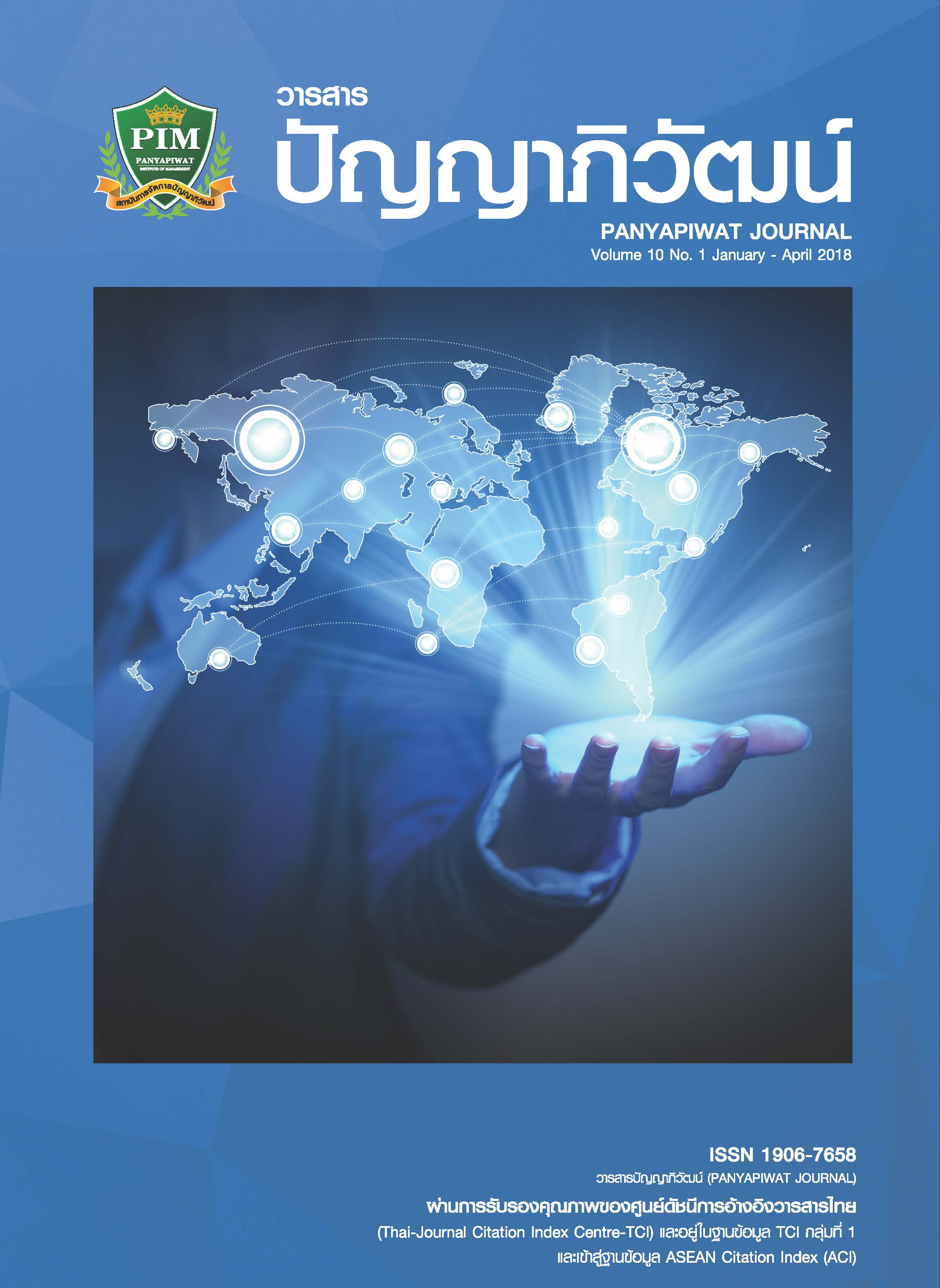ผลการใช้นวัตกรรมการเรียนรู้ตามแนวทฤษฎีคอนสตรัคติวิสต์ที่ส่งเสริมการสร้างความรู้และการคิดสร้างสรรค์ ในศตวรรษที่ 21 สำหรับนักศึกษาระดับอุดมศึกษา
Main Article Content
บทคัดย่อ
การศึกษาครั้งนี้มีวัตถุประสงค์เพื่อศึกษาการสร้างความรู้ การคิดสร้างสรรค์ ผลสัมฤทธิ์ทางการเรียน และความคิดเห็นของผู้เรียนที่เรียนด้วยนวัตกรรมการเรียนรู้ตามแนวทฤษฎีคอนสตรัคติวิสต์ ที่ส่งเสริมการสร้างความรู้และการคิดสร้างสรรค์ ในศตวรรษที่ 21 สำหรับนักศึกษาระดับอุดมศึกษา ซึ่งเป็นการวิจัยเชิงทดลอง กลุ่มตัวอย่าง คือ นักศึกษาชั้นปีที่ 3 จำนวน 27 คน ได้มาจากการสุ่มแบบยกกลุ่ม ในรายวิชานวัตกรรมและเทคโนโลยีสารสนเทศทางการศึกษา ภาคเรียนที่ 2/2559 ผลการศึกษามีดังนี้ 1) ผลการสร้างความรู้ของผู้เรียน พบว่า ผู้เรียนสร้างความรู้จากการเสียสมดุลทางปัญญา เมื่อผู้เรียนได้รับปัญหาผู้เรียนจะเกิดความสงสัยและตั้งคำถามเกี่ยวกับปัญหาที่รับ และปรับโครงสร้างทางปัญญาจากค้นหาคำตอบจากแหล่งเรียนรู้ที่จัดเตรียมไว้โดยวิธีการดูดซึม และการปรับเปลี่ยนโครงสร้างทางปัญญา รวมทั้งการปฏิสัมพันธ์ทางสังคมโดยการแลกเปลี่ยนเรียนรู้จากเพื่อนๆ หรือผู้รู้ 2) ผลการคิดสร้างสรรค์ของผู้เรียน ประกอบด้วยการคิดคล่อง การคิดยืดหยุ่น การคิดริเริ่ม และการคิดละเอียดลออ 3) ผลการเปรียบเทียบผลสัมฤทธิ์ทางการเรียนของผู้เรียน พบว่า คะแนนสอบหลังเรียนของนักเรียนสูงกว่าก่อนเรียนอย่างมีนัยสำคัญทางสถิติที่ระดับ .05 และ 4) ความคิดเห็นของผู้เรียน ประกอบด้วยด้านเนื้อหา ด้านสื่อมัลติมีเดีย และด้านการออกแบบ
This study aimed to study the knowledge construction, creative thinking, learning achievement and students’ opinions of the learner learning with constructivist learning environment to enhance knowledge construction and creative thinking in 21st century for the graduate students. This research design is an experimental research. The sample group was the 27 junior students collected by cluster random sampling registered in Educational Innovation and Information Technology subject in the second semester of 2016. The results of using the innovation were found as the following: 1) the students’ knowledge construction was found that the students constructed their knowledge from disequilibrium. When the learner receives a problem, the student becomes suspicious and asks questions about the problem. The learners will restructure their cognitive abilities by finding the answers from the resources provided by the methods of assimilation and accommodation including social interaction by sharing with friends or experts, 2) the students’ creative thinking comprised of fluency, flexibility, originality, and elaboration, 3) the comparison of their learning achievement were found that the their posttest scores were significantly higher than pretest at .05, and 4) the students’ opinions inheres in content, multimedia, and design.
Article Details
“ข้าพเจ้าและผู้เขียนร่วม (ถ้ามี) ขอรับรองว่า บทความที่เสนอมานี้ยังไม่เคยได้รับการตีพิมพ์และไม่ได้อยู่ระหว่างกระบวนการพิจารณาลงตีพิมพ์ในวารสารหรือแหล่งเผยแพร่อื่นใด ข้าพเจ้าและผู้เขียนร่วมยอมรับหลักเกณฑ์การพิจารณาต้นฉบับ ทั้งยินยอมให้กองบรรณาธิการมีสิทธิ์พิจารณาและตรวจแก้ต้นฉบับได้ตามที่เห็นสมควร พร้อมนี้ขอมอบลิขสิทธิ์บทความที่ได้รับการตีพิมพ์ให้แก่สถาบันการจัดการปัญญาภิวัฒน์หากมีการฟ้องร้องเรื่องการละเมิดลิขสิทธิ์เกี่ยวกับภาพ กราฟ ข้อความส่วนใดส่วนหนึ่งและ/หรือข้อคิดเห็นที่ปรากฏในบทความข้าพเจ้าและผู้เขียนร่วมยินยอมรับผิดชอบแต่เพียงฝ่ายเดียว”
เอกสารอ้างอิง
Antanin, T. (2016). Development of Web-based instruction Based on the Constructivist Theory to Promote Students' Creativity in Learning Introduction to Television Production Communication Arts Program, Rajabhat Maha Sarakham University. Master degree thesis in Computer Education, Graduate School, Rajabhat Maha Sarakham University. [in Thai]
Asavapisit, P. (2009). Creative Thailand. Intellectual Property Journal 5(3), 1-4. [in Thai] Chaijaroen, S. (2016). Instructional Design: Principles and Theories to Practices (2nd ed.). Khonkaen: Penprinting. [in Thai]
Garnett, J. C. M. (1919). General ability, cleverness and purpose. British Journal of Psychology, 9, 345-366.
Guilford, J. P. (1967). The nature of human intelligence. New York: McGraw-Hill. Khanjug, I., Chajaroen, S., Samat, C., Seehamath, P. & Seeja-morn, S. (2009). Study Learner's Knowledge Construction process Learning with Learner's Knowledge Construction Learning Innovation based on Thai Wisdom and Thai Living. (The research report). Faculty of Education, Khon Kean University. [in Thai]
Kwangmuang, P. (2017). The Design and Development of Constructivist Learning Innovation to Enhance Creative Thinking in 21th Century Learning for Higher Education. Full Paper Proceeding BESSH-2017, 409(12), 6-14.
Kwangmuang, P. & Chaijaroen, S. (2016). The result of synthesis framework of learning environment model enhance information processing for the learners integrating between pedagogy and neuroscience. Panyapiwat Journal, 8(3), 188-201. [in Thai]
Kwangmuang, P. (2016). The Development of Learning Environment Model to Enhance Learner's Information Processing Integration Between Pedagogy and Neuroscience. Doctor of Philosophy Thesis in Educational Technology, Graduate School, Khon Kaen University. [in Thai]
Kwangmuang, P. (2017). The Design and Development of Constructivist Learning Innovation to Enhance Creative Thinking in 21th Century Learning for Higher Education. Full Paper Proceeding BESSH-2017, 409(12), 6-14.
Kwangmuang, P. & Chaijaroen, S. (2016). The result of synthesis framework of learning environment model enhance information processing for the learners integrating between pedagogy and neuroscience. Panyapiwat Journal, 8(3), 188-201. [in Thai]
Kwangmuang, P. (2016). The Development of Learning Environment Model to Enhance Learner's Information Processing Integration Between Pedagogy and Neuroscience. Doctor of Philosophy Thesis in Educational Technology, Graduate School, Khon Kaen University.[in Thai]
Office of the Education Council. (2016). The study to review manpower requirements for to plan the production and human resource development of the country. Bangkok. Office of the Education Council.
Piaget, J. (1936). Origins of intelligence in the child. London: Routledge & Kegan Paul.
Ruengrong, P., Jiravarapong, B., Manyum, W., Somyaron, W., Muendet, S. & Srisurat, C. (2014). Educational technology VS Thai teacher in 21st Century. Panyapiwat Journal, 5(Special Issue), 195-207. [in Thai]
Samat, C. & Chaijaroen, S. (2009). Design and Development of Constructivist Web-Based Learning Environment Model to Enhance Creative Thinking for Higher Education Students. Rajabhat Maha Sarakham University Journal, 3(2), 161-172. [in Thai]
Srisa-ard, B. (2010). Basic Research (8th ed.). Bangkok: Suviriyasarn. [in Thai] Techapompong, O. & Chaijaroen, S. (2017). Framework of Constructivist Web-based Learning Environment Model to Enhance Creative Thinking: Integration Pedagogy and Neuroscience Academic Resources, Prince of Songkla University, 28(1), 118-129. [in Thai]
Torrance, E. P. (1972). Can we teach children to think creatively?. Journal of Creative Behavior, 6(2), 114-143.
Vygotsky, L. (1925). Etudes on the pre-history of cultural-historical psychology. European Studies in the History of Science and Ideas, 8, 251-281.


